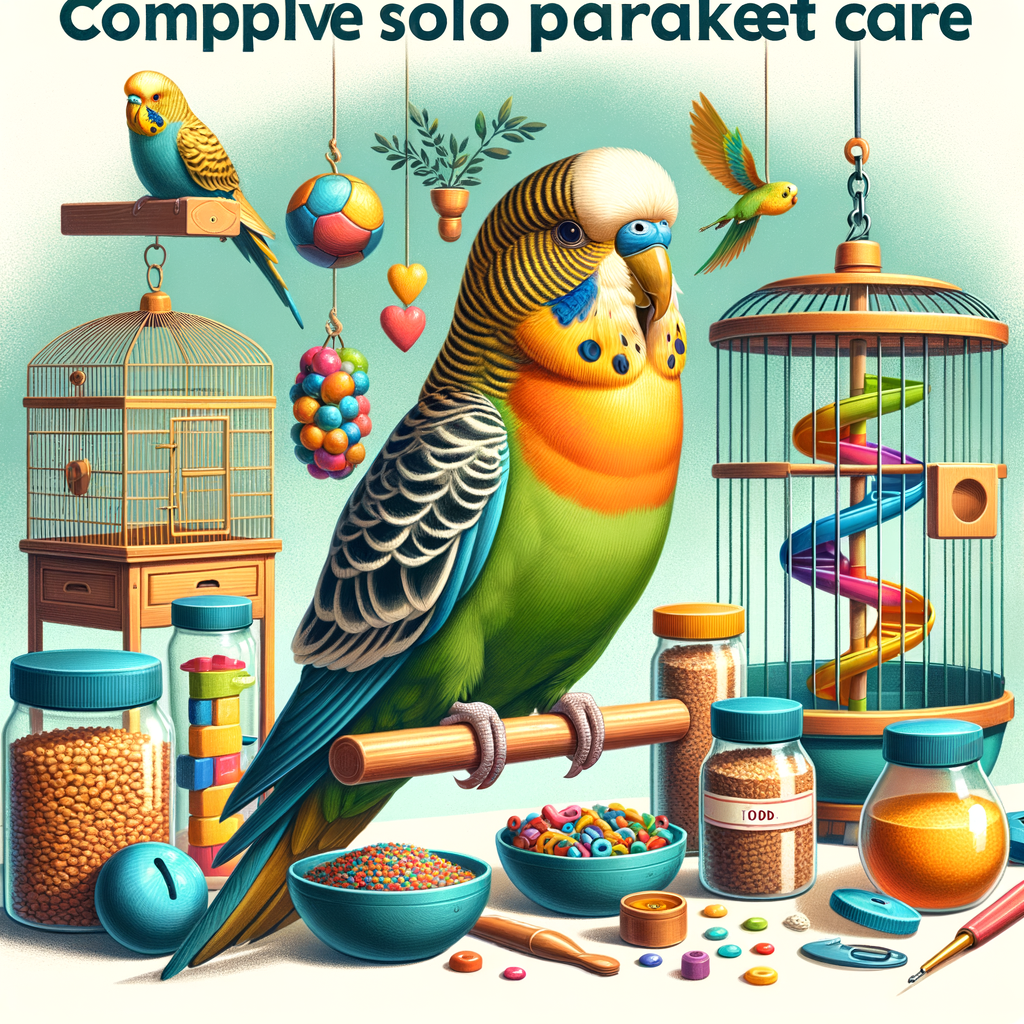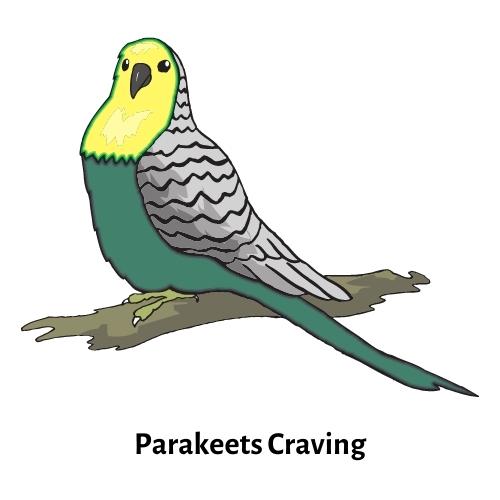
Introduction to Solo Parakeet Care
Parakeets, also known as budgies, are delightful pets that bring joy and companionship to their owners. When you have a solo parakeet, understanding their needs and providing appropriate care is crucial. In this section, we will delve into the unique needs of a single parakeet and discuss the challenges and rewards of caring for one.
- Understanding the Needs of a Single Parakeet
- Challenges and Rewards of Caring for a Solo Parakeet
Parakeets are social creatures by nature. When you have a single parakeet, it’s important to provide them with plenty of interaction and stimulation. They need a balanced diet, a clean and safe environment, and plenty of toys for mental stimulation. Regular vet check-ups are also essential to ensure your parakeet stays healthy.
Caring for a solo parakeet can be both challenging and rewarding. One of the main challenges is ensuring your parakeet gets enough social interaction. This may mean spending several hours a day interacting with your bird. However, the rewards are immense. Parakeets are intelligent and affectionate pets that can form strong bonds with their owners. They can learn to mimic human speech and can be trained to do tricks, providing endless entertainment and companionship.
In the following sections, we will delve deeper into the specifics of solo parakeet care, including basic care tips, advanced care strategies, enrichment activities, socialization tips, and how to deal with loneliness in a single bird. By the end of this guide, you will be well-equipped to provide the best possible care for your solo parakeet.
Single Parakeet Care Basics
When it comes to caring for a single parakeet, understanding the basics is crucial. This includes providing the right habitat and diet for your feathered friend. Let’s start with the habitat.
Parakeet Habitat
A parakeet’s habitat is more than just a cage. It’s their home, their safe space, and the place where they will spend most of their time. Therefore, it’s essential to make it as comfortable and suitable as possible.
- Choosing the right cage for a single parakeet
- Creating a safe and comfortable environment
The size of the cage matters a lot. A small cage can make your parakeet feel cramped and stressed. On the other hand, a cage that is too large can make them feel insecure. The ideal cage size for a single parakeet is around 20 inches wide, 20 inches deep, and 30 inches high. The cage should also have horizontal bars to allow your parakeet to climb and exercise.
Once you’ve chosen the right cage, it’s time to make it comfortable. This includes adding perches of different sizes and materials for your parakeet to rest and play. You should also provide toys to keep them entertained. Ensure the cage is placed in a quiet, well-lit area, away from drafts and direct sunlight. Regular cleaning is also necessary to maintain a healthy environment.
Remember, a happy parakeet is a healthy parakeet. Providing the right habitat is the first step towards ensuring their well-being.
Parakeet Diet
When it comes to taking care of a parakeet, understanding their dietary needs is crucial. The right diet can ensure your bird’s health and longevity. Let’s delve into the essentials of parakeet nutrition and how to choose the right food for your feathered friend.
- Understanding Parakeet Nutrition
Parakeets, also known as budgies, are small birds with big nutritional needs. They require a balanced diet that includes a variety of foods to stay healthy. The main components of a parakeet’s diet should be seeds, fruits, vegetables, and grains. These provide the necessary vitamins, minerals, and nutrients that your bird needs.
Seeds are a parakeet’s primary food source, but they should not be the only thing your bird eats. While seeds are high in fat and protein, they lack other essential nutrients. Fruits and vegetables can fill in these nutritional gaps. They provide vitamins and minerals that seeds don’t, such as Vitamin A and C. Grains, like cooked quinoa or brown rice, can also be a good source of carbohydrates.
It’s important to note that not all foods are safe for parakeets. Avocado, chocolate, and caffeine are toxic to birds and should be avoided. Always research before introducing a new food to your bird’s diet.
- Choosing the Right Food for Your Bird
Choosing the right food for your parakeet can seem daunting, but it doesn’t have to be. Start with a high-quality seed mix designed for parakeets. These mixes usually contain a variety of seeds, grains, and sometimes dried fruits and vegetables. They are a good base for your bird’s diet.
Next, supplement the seed mix with fresh fruits and vegetables. Try to offer a variety of colors, as different colored fruits and veggies provide different nutrients. For example, carrots are high in Vitamin A, while bell peppers are a good source of Vitamin C.
Lastly, remember to provide fresh water daily. Birds, like humans, need water for digestion and hydration. A clean water dish is also important for your bird’s health.
Remember, every bird is unique. What works for one parakeet may not work for another. It’s important to monitor your bird’s health and adjust their diet as needed. If you’re ever unsure about your bird’s diet, don’t hesitate to consult with a vet.
By understanding parakeet nutrition and choosing the right food, you can help ensure your bird lives a long, healthy life. Happy feeding!
Advanced Solo Parakeet Tips
As a parakeet owner, it’s important to understand the advanced aspects of solo parakeet care. This section will focus on parakeet behavior, providing you with insights into understanding parakeet communication and managing behavioral issues.
Parakeet Behavior
Parakeet behavior can be complex and intriguing. Understanding their communication and managing behavioral issues can lead to a more fulfilling relationship with your feathered friend.
- Understanding parakeet communication
- Managing behavioral issues
Parakeets communicate in various ways. They use vocalizations, body language, and even feather displays to express their feelings and intentions. For example, a happy parakeet might chirp and sing, while a scared parakeet might puff up its feathers. Understanding these signs can help you better respond to your parakeet’s needs.
Parakeets can sometimes exhibit behavioral issues such as biting, screaming, or feather plucking. These behaviors are often a sign of stress or boredom. To manage these issues, ensure your parakeet has a stimulating environment with plenty of toys and activities. Regular interaction with you can also help keep your parakeet happy and well-behaved.
In conclusion, understanding and managing parakeet behavior is a key aspect of advanced solo parakeet care. By paying attention to your parakeet’s communication and addressing any behavioral issues, you can ensure a happy and healthy life for your feathered friend.
Parakeet Health
One of the most important aspects of caring for a solo parakeet is ensuring its health. This involves recognizing signs of illness and making sure your bird receives regular vet check-ups and vaccinations. Let’s delve into these two crucial points.
- Recognizing Signs of Illness
Parakeets, like many other birds, are good at hiding their illnesses. This is a survival instinct in the wild, but it can make it difficult for pet owners to realize when their bird is sick. However, there are some signs you can look out for:
- Changes in behavior: If your parakeet is less active than usual, or shows a sudden change in behavior, it could be a sign of illness.
- Loss of appetite: A sick parakeet may eat less or not at all.
- Changes in droppings: Unusual color, consistency, or frequency in your bird’s droppings can indicate a health problem.
Remember, these are just a few examples. If you notice any changes in your parakeet’s behavior or physical condition, it’s best to consult a vet.
- Regular Vet Check-ups and Vaccinations
Regular vet visits are essential for your parakeet’s health. A vet can conduct a thorough examination and detect any potential health issues early. During these visits, your bird can also receive necessary vaccinations to prevent common bird diseases.
| Common Parakeet Vaccinations | Why It’s Important |
|---|---|
| Psittacosis | Also known as ‘parrot fever’, this bacterial infection can cause respiratory issues and other serious health problems in parakeets. |
| Polyomavirus | This virus can cause feather abnormalities, weight loss, and in severe cases, death. Vaccination can help protect your bird. |
Remember, the best way to ensure your parakeet’s health is through preventative care. Regular vet visits, a balanced diet, and a clean living environment can go a long way in keeping your bird healthy and happy.
Parakeet Care Guide: Enrichment Activities
Parakeets, also known as budgies, are intelligent and active birds that require mental and physical stimulation to stay healthy and happy. This section of our guide will focus on enrichment activities that can help your parakeet thrive.
- Interactive toys for mental stimulation
- Training your parakeet for physical exercise
Interactive toys are a great way to keep your parakeet mentally stimulated. These can range from simple toys like bells and mirrors to more complex puzzle toys. For example, a toy with hidden compartments that your parakeet has to figure out how to open can provide hours of entertainment and mental exercise. Remember, variety is key. Regularly rotating the toys in your parakeet’s cage will keep them interested and engaged.
Physical exercise is just as important as mental stimulation for a parakeet. Training your parakeet to do simple tricks can provide this much-needed exercise. Start with simple commands like ‘step up’ onto your finger. Once your parakeet has mastered this, you can move on to more complex tricks like flying to you on command. Not only does this provide physical exercise, but it also strengthens the bond between you and your parakeet.
Remember, every parakeet is unique and what works for one might not work for another. It’s important to observe your parakeet and adjust their enrichment activities based on their preferences and abilities. With patience and consistency, you can create a stimulating environment that will help your parakeet thrive.
Solo Flight Parakeet Care: Socialization
Parakeets are social creatures by nature. They thrive on interaction and companionship. When they are kept as single pets, it becomes even more important to ensure they receive adequate socialization. This section will explore the importance of human interaction and how to introduce your parakeet to other pets.
- Importance of Human Interaction
Parakeets are intelligent birds that crave interaction. When they are kept alone, their human family becomes their flock. Spending quality time with your parakeet is crucial for their mental and emotional well-being. It helps them feel loved, secure, and part of a community.
Interaction can take many forms. It can be as simple as talking to your parakeet, letting them out of their cage to explore, or teaching them new tricks. Parakeets are known for their ability to mimic sounds, so you can even try teaching them to talk!
Remember, consistency is key. Try to spend at least an hour a day interacting with your parakeet. This will help build a strong bond and keep your feathered friend happy and healthy.
- Introducing Your Parakeet to Other Pets
Introducing your parakeet to other pets can be a great way to provide additional socialization. However, it must be done carefully to ensure the safety of all animals involved.
Start by allowing your parakeet and other pet to observe each other from a safe distance. This can be done by placing your parakeet’s cage in the same room as your other pet, but far enough away to prevent any accidental injuries.
Monitor their reactions closely. If both pets seem calm and curious, you can gradually move the cage closer over a period of several days. Never leave your parakeet unsupervised with another pet, and always be prepared to intervene if necessary.
Remember, every pet is unique. Some may never feel comfortable around other animals, and that’s okay. The most important thing is to respect your parakeet’s comfort level and prioritize their safety at all times.
Single Bird Care: Dealing with Loneliness
When it comes to caring for a single parakeet, one of the most significant challenges you might face is dealing with your bird’s loneliness. Parakeets are social creatures, and when left alone, they can feel isolated and lonely. This section will guide you through the signs of loneliness in your parakeet and provide you with effective ways to keep your bird entertained.
- Signs your parakeet might be lonely
- Excessive Screaming: If your parakeet is making loud, continuous noises, it might be a sign of distress or loneliness.
- Feather Plucking: This is a common sign of stress in birds. If your parakeet is plucking its feathers, it might be feeling lonely.
- Loss of Appetite: A lonely parakeet might lose interest in food, leading to weight loss and other health issues.
- Decreased Activity: If your parakeet is less active than usual, it might be feeling lonely and depressed.
- Ways to keep your parakeet entertained
- Interactive Toys: Toys that make noise or have moving parts can keep your parakeet entertained for hours.
- Music or TV: Leaving the radio or TV on can provide your parakeet with some background noise and make it feel less alone.
- Regular Interaction: Spend time talking to your parakeet every day. Your voice can provide comfort and companionship.
- Change of Scenery: Moving your parakeet’s cage to a different location in your home can provide new sights and sounds to explore.
Recognizing the signs of loneliness in your parakeet is the first step towards addressing the issue. Here are some common signs:
Keeping your parakeet entertained can help alleviate feelings of loneliness. Here are some effective ways to keep your bird engaged:
Remember, every parakeet is unique and might show different signs or respond differently to various forms of entertainment. The key is to observe your bird closely and respond to its needs. With patience and care, you can help your parakeet overcome feelings of loneliness and lead a happy, healthy life.
Conclusion: Key Takeaways for Solo Parakeet Care
As we wrap up our comprehensive guide on solo parakeet care, let’s revisit the most crucial points to ensure your feathered friend lives a happy, healthy, and fulfilling life.
- Understanding and Meeting Your Parakeet’s Needs
- Providing a Stimulating and Enriching Environment
- Regular Health Checks and Proper Nutrition
Knowing your parakeet’s needs is fundamental to its well-being. Parakeets are social creatures that require interaction and stimulation. They need a minimum of 10-12 hours of sleep per day, and their diet should consist of 70% high-quality bird pellets and 30% fresh fruits and vegetables. Remember, every parakeet is unique and may have specific needs based on its age, health, and personality.
Parakeets thrive in environments that stimulate their minds and bodies. Provide a variety of toys that encourage foraging, puzzle-solving, and physical activity. Regularly rotate these toys to keep your parakeet’s environment fresh and exciting. Also, ensure the cage is spacious enough for your bird to fly and explore.
Regular health checks are essential to detect any potential health issues early. Monitor your parakeet’s behavior, droppings, and physical appearance for any changes. A balanced diet is also crucial for your parakeet’s health. As mentioned earlier, a diet consisting of high-quality pellets, fresh fruits, and vegetables will ensure your parakeet gets all the necessary nutrients.
In conclusion, caring for a solo parakeet can be a rewarding experience. It requires understanding, patience, and commitment. By following these key takeaways, you can ensure your parakeet lives a long, healthy, and happy life.













